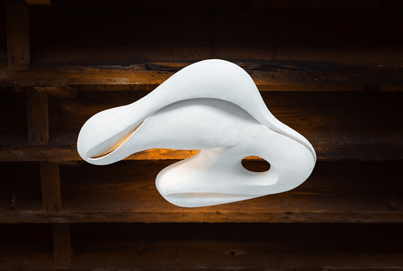
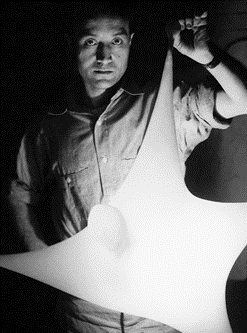
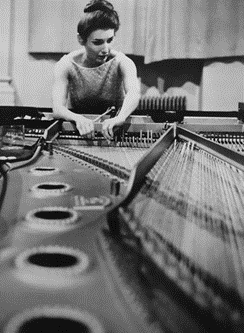
Left to right: Marie Menken with her Bolex camera. Photo: William Wood. Isamu Noguchi with Study for Luminous Plastic Sculpture, 1943. The Noguchi Museum Archives, 03766. © The Isamu Noguchi Foundation and Garden Museum, NY / Artists Rights Society (ARS). Lucia Dlugoszewski playing timbre piano. Photo: Courtesy of the Erick Hawkins Dance Foundation, Inc.
New York (July 2023) — The Isamu Noguchi Foundation and Garden Museum — the first museum in the United States to be established, designed and installed by a living artist to show their own work—is pleased to announce A Glorious Bewilderment: Marie Menken’s ‘Visual Variations on Noguchi.’ The exhibition, curated by Noguchi Museum Curator Kate Wiener, will span most of the Museum’s second floor with a focus on experimental American filmmaker Marie Menken’s (1909–1970) film, Visual Variations on Noguchi (c.1945–46/1953). This exhibition marks the first time the film will be screened at The Noguchi Museum, and 2023 also marks the 100th anniversary of the invention of 16mm film. While Visual Variations on Noguchi is appreciated in avant-garde film circles because of the impact of Menken’s pioneering hand-held camera work, this exhibition will, for the first time, explore in depth Isamu Noguchi’s work and studio as the film’s subject matter, and the previously unrecognized affinities between Menken’s work in film, Noguchi’s interlocking and illuminated sculptures, and composer Lucia Dlugoszewski’s score for the film.
Visual Variations on Noguchi (16 mm, black and white, sound, 4 min.), Menken’s first solo film, was shot in Isamu Noguchi’s MacDougal Alley studio in New York City’s Greenwich Village. Using a hand-cranked Bolex camera, Menken moved rapidly in and around Noguchi’s sculptures producing a disorienting and captivating portrait of Noguchi’s work in motion. Menken’s filmic technique, characterized by hand-held shots and ambulatory movement, became highly influential for a new generation of experimental filmmakers, including Kenneth Anger, Stan Brakhage, Jonas Mekas, and Andy Warhol.
A Glorious Bewilderment provides an in-depth exploration of the film and the interconnectedness and shared artistic vision between Menken and Noguchi. It celebrates Menken’s invitation to bring the full force of our moving bodies to Noguchi’s sculptures, echoing Noguchi’s belief that “sculptures move because we move.” The exhibition will also reveal composer Lucia Dlugoszewski’s role in creating a jarring and haunting score that enhances the film’s disorienting effect. By examining their respective contributions to Visual Variations on Noguchi, this exhibition offers the opportunity to newly appreciate the artists’ related contentions, which were developed in the face of post-war anguish but remain equally relevant in our own fractured moment, that “art postpones death” (Menken), “that bewilderment is glorious” (Dlugoszewski), and that “it is out of this mess that our poetry must come” (Noguchi).
“It is an honor and joy to screen Marie Menken’s Visual Variations on Noguchi at The Noguchi Museum for the first time and introduce new audiences to her spirited and pioneering practice, which is still largely underappreciated,” says Kate Wiener, Curator at The Noguchi Museum. “The film’s torrent of images and surreal soundtrack by Lucia Dlugoszewski conjures an inspiring sense of freedom and ecstasy in its embrace of fragmentation and movement. Showing this work at The Noguchi Museum alongside Noguchi’s related sculptures gives us a unique opportunity to reexamine its relationship with its titular subject and to illuminate the shared connections between Menken, Dlugoszewski, and Noguchi.”
BACKGROUND

Although still largely underrecognized, Marie Menken was a pioneer in American avant-garde cinema whose innovative handheld camerawork and riotous movement introduced a new approach to filmmaking that proved deeply influential in the world of experimental film. In Menken’s first solo film Visual Variations on Noguchi, shot in Isamu Noguchi’s studio in New York with a hand-held Bolex camera, Menken first experimented with the rapid movements and pulsing rhythm that defined her radical approach to filmmaking. The film was originally silent, but in 1953, composer Lucia Dlugoszewski, a friend of both Menken and Noguchi, produced an equally jarring soundtrack for the film which pieces together a haunting collage of discordant sounds. Although there are no records of Noguchi’s response to the film in his own writings and archive, Menken recounted, “when [Noguchi] saw the footage, he was entertained and delighted. So was I.”
To date, discussions of this film have tended to focus on Menken’s pioneering filmic strategies, and how, with her rapid movements, she effectively translated, transformed, or obscured Noguchi’s sculptures. While it is challenging to identify specific sculptures in the fast-paced frames of Menken’s film, this exhibition offers the context to reconsider the importance of Menken’s subject—Noguchi—and how her approach may be understood not as a distortion of his work, but rather as an embrace of Noguchi’s own invitation to step in and find new meaning. Pairing Visual Variations on Noguchi and other select films by Menken with a collection of Noguchi’s related sculptures, this exhibition offers space to explore the interplay and affinities between these artists’ otherwise seemingly disparate practices: particularly, their shared sense of the liberatory capacity of fracture and fragmentation, and the nature of flickering light.
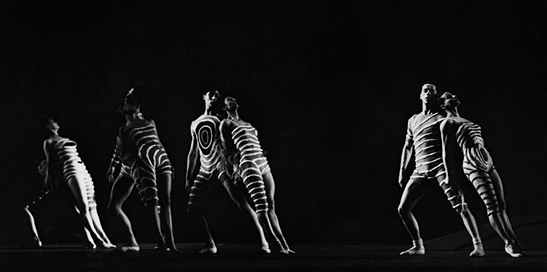
EXHIBITION
A Glorious Bewilderment will span The Noguchi Museum’s second floor and will feature Marie Menken’s four-minute film, Visual Variations on Noguchi, projected in its original 16mm format.
The exhibition is broken up into various sections: the first explores the connection between Noguchi and Menken through their shared involvement in the world of dance and their mutual concern for the “flying spirit of movement.” Although the exact details of Noguchi and Menken’s initial meeting are unclear, they were involved in their first and only other collaboration for
the ballet The Seasons in 1947, choreographed by Merce Cunningham with music by John Cage. Noguchi designed costumes and scenery for the ballet, and Menken likely helped produce the now-lost films of fire, rain, and ice that were projected behind the dancers. Archival materials related to The Seasons and a later film of Menken’s titled Hurry Hurry (1957) will be presented to provide clues into the nature of that collaboration. Also on view will be works that demonstrate Noguchi’s interests in kinetic energy and propulsive movement, including his plywood props for Martha Graham’s Herodiade (1944) which directly influenced the creation of his biomorphic slab sculptures seen in Menken’s film.
The exhibition’s next section will feature a number of Noguchi’s interlocking sculptures that either appear in or are closely related to the works that appear in Menken’s film, alongside enlarged film stills from Visual Variations on Noguchi. Visitors will be encouraged to take inspiration from Menken’s raucous non-linear movement between Noguchi’s works and will be invited to chart their own paths in and around his sculptures. This section will also focus on Menken and Noguchi’s shared interests in fracture, precarity, and fragmentation. The works that Noguchi made in the mid 1940s—which appear in Menken’s film and will be on view in the exhibition—were often held together in tenuous balance and betrayed Noguchi’s new sense of despair having seen the world torn apart by atomic war. Rather than seeking the resolution
or static coherence of these composite sculptures, Menken embraces and expands the sense of fracture inherent in Noguchi’s work through disorientating movements, tilts, and rapid shifts in perspective. The final section highlights the shared significance of light in Menken and Noguchi’s work. On view will be a selection of Noguchi’s electrically-illuminated magnesite sculptures, known
as “Lunars,” which Menken explored in Visual Variations on Noguchi by tracing their illuminated surfaces and creating a captivating flurry of light on the screen. Noguchi’s Lunars will be presented alongside a selection of Menken’s work that reveals her longstanding interest in the nature of flickering light, including her two later films Moonplay (1964) and Lights (1966), and a thickly textured painted folding screen (1956)—a special loan from Anthology Film Archives. Menken began her career as a painter, and as showcased in her painted screen, she often incorporated unconventional materials into her works to produce sparkling tactile surfaces that interact with changing light and viewer movement.
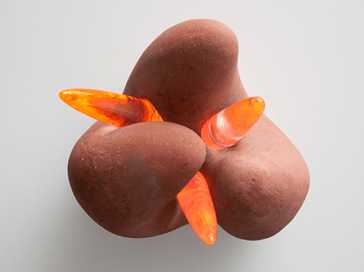
The final section of the exhibition will be a reading room, where visitors will be able to learn more about Menken, Noguchi, and Dlugoszewski through archival materials and secondary sources. Also on view will be select footage from The Noguchi Museum’s newly digitized Multimedia Collection—which will represent a very different approach to documenting Noguchi’s interest in movement, light, and fragmentation on film.
SPECIAL THANKS
Exhibitions at The Noguchi Museum are supported, in part, by public funds from the New York City Department of Cultural Affairs, in partnership with the City Council and from the New York State Council on the Arts with the support of the Office of the Governor and the New York State Legislature.
The Noguchi Museum extends a special thank you to Anthology Film Archives; Erick Hawkins Dance Foundation, Inc.; The Film-Makers’ Cooperative; Music Division, Library of Congress; and Mono No Aware.
The Noguchi Museum
9-01 33rd Rd, Queens, NY 11106, United States
